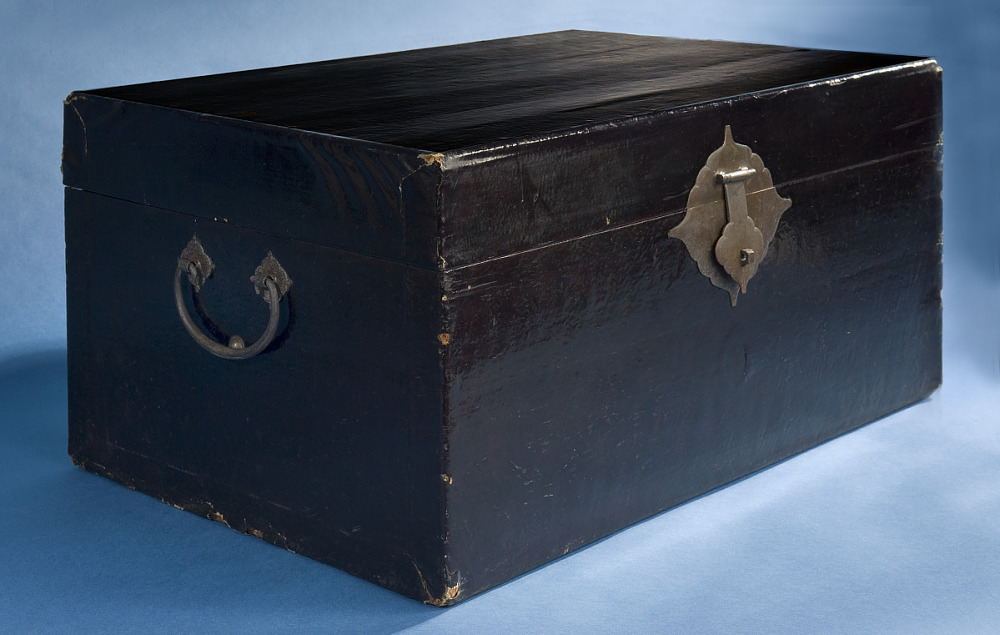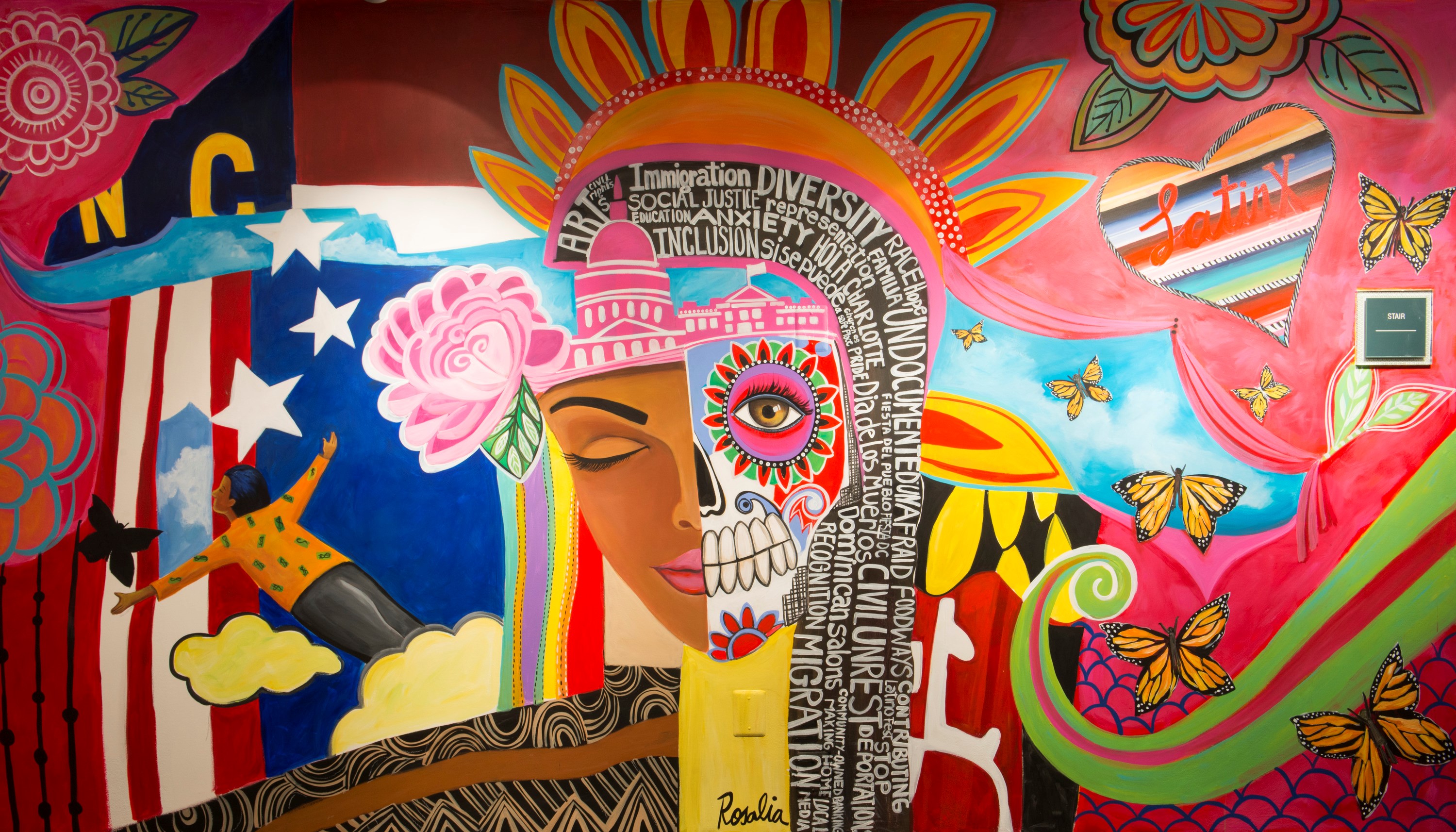As COVID-19 deaths spiked in 2020, Suzanne Firstenberg’s public art installation "In America: How could this happen…"
Asian American and Pacific Islander Heritage Month
Examine collections of the Museum's key resources on major themes in American history and social studies teaching. Additional resources can be found in the main search areas of the website.
1895 - 1900 Chinese American Man's Slippers
Resource Type(s): Artifacts, Primary Sources,
Date Posted: 9/3/2020
Mr. Lee only wore these slippers in his home or with his traditional Chinese clothes on special occasions. The slipper sole was thick, flat, inelastic, and shorter than the upper sole to give enough spring for walking. For much of his early life, the Chinese New Year was Lee’s only day of rest from the Quong Yuen Shing & Co. general store and a time when he might wear these slippers.
1906 Chinese Immigrant’s Lacquer Trunk
Resource Type(s): Artifacts, Primary Sources,
Date Posted: 9/3/2020
In 1906 Ng Shee Lee packed her clothes and belongings in this trunk and left China for America. It was a difficult trip. She slept next to the noisy engine room; arriving tired and sick in San Francisco she was met by the devastating 1906 earthquake. Ng Shee then made her way alone by train across Canada to New York where she rejoined her husband, Lee B. Lok.
Becoming US
Resource Type(s): Primary Sources, Lessons & Activities, Worksheets,
Date Posted: 2/7/2020
Becoming US is a new educational resource for high school teachers and students to learn immigration and migration history in a more accurate and inclusive way. The people of North America came from many cultures and spoke different languages long before the founding of the United States, even before European contact. At the center of Becoming US is the understanding that some people were already in the land that is today the United States, some people were brought against their will, some people came voluntarily, and some people never moved but became part of the United States as its border expanded to include them. Cover five units with your students: Borderlands, Education, Policy, Belonging, and Resistance.
Congressional Gold Medal Experience
Resource Type(s): Interactives & Media,
Date Posted: 5/16/2013
Nearly seven decades after the beginning of World War II, the Congressional Gold Medal was bestowed on the Japanese American men who served with bravery and valor on the battlefield, even while their families were held in internment camps by the very country for which they fought. Through videos, discussion forums, and three lesson plans, the Congressional Gold Medal Experience site focuses on how the stories of the honorees reflect outstanding character traits, such as courage and perseverance. This site was produced through collaboration between the Smithsonian Asian Pacific American Center and the National Veterans Network.
National Youth Summit: Japanese American Incarceration in World War II
Resource Type(s): Interactives & Media,
Duration: 60 Minutes
Date Posted: 5/27/2016
During World War II, the United States government forcibly removed over 120,000 Japanese Americans from the Pacific Coast. These individuals, two-thirds of them U.S. citizens, were sent to ten camps built throughout the western interior of the United States. Many would spend the next three years living under armed guard, behind barbed wire. In this webcast, the panelists explored this period in American history and considered how fear and prejudice can upset the delicate balance between the rights of citizens and the power of the state.
Poster in Korean stating “Today we march, tomorrow we vote”
Resource Type(s): Artifacts, Primary Sources,
Date Posted: 9/3/2020
The May 1, also known as May Day, celebrates workers’ rights and is often marked by public marches. Constantly being adapted, May Day has seen many evolutions since its start at the Haymarket Square in Chicago in 1886. One demonstration of great significance is the May Day marches of 2006, in which immigrant rights organizers adapted that symbolic day to call upon the working conditions and contribution of immigrant workers. Beginning in February and culminating on May 1, an estimated 3.5 to 5 million people participated in the marches that were a response to the Border Protection, Antiterrorism and Illegal Immigration Control Act of 2005, which if passed would affect millions of undocumented immigrants by increasing interior enforcement and re-verification of workers throughout the country. An estimate of 73 mobilizations took place across the United States on May 1, with Los Angeles and Chicago seeing the highest number of participants (an estimated 650,000 in each city). Its goal was to raise awareness of immigrant laborers working conditions, to show their economic contribution to this nation by striking and students walking out from school and brought in new people (families and older generations) to the political stage. Considered one of the largest immigrant rights demonstrations to have taken place in U.S. history and put right front in center immigrants from all backgrounds, and especially Latinos, as political participants of their own causes. Poster in Korean stating “Today we march, tomorrow we vote.”
Righting a Wrong: Japanese Americans and World War II
Resource Type(s): Reference Materials, Primary Sources,
Date Posted: 4/16/2018
February 2017 marked the 75th anniversary of Executive Order 9066, a document that President Roosevelt signed in 1942, two months after Japan’s attack on Pearl Harbor. The order resulted in the imprisonment of 75,000 Americans of Japanese ancestry and 45,000 Japanese nationals in prison camps across the country, many being relocated far from home. Some 40 years later, the U.S. Congress formally recognized that the rights of the Japanese American community had been violated and President Reagan signed the Civil Liberties Act of 1988, providing an apology and restitution to the living Japanese Americans who were incarcerated during World War II.
The exhibition explores this history through the Executive Order 9066 document on loan from the National Archives; original artwork by Roger Shimomura, who spent several years in the Minidoka Camp in Idaho; historic images; and objects.
Image: Identification Button
Teaching Japanese American Incarceration through Comics
Resource Type(s): Lessons & Activities,
Date Posted: 5/17/2016
Students will learn about the personal experiences of Japanese American incarcerees during World War II and will practice communicating information concisely by developing an original comic.
Vietnam Documentary Footage of the Huey Helicopter
Resource Type(s): Interactives & Media,
Duration: 3 Minutes
Date Posted: 6/20/2010
Huey Helicopter: Air Armada - selections from documentary on the use of the Huey during the Vietnam War.
This video is part of the Price of Freedom learning resources package for use with the The Soldiers Experience lesson plan. It was produced to accompany the exhibition The Price of Freedom: Americans at War, by the Smithsonian's National Museum of American History.
Viral Histories: Stories of Racism, Resilience, and Resistance in Asian American Communities
Resource Type(s): Interactives & Media,
Duration: 60 Minutes
Date Posted: 3/18/2021
Viral Histories is a collection of conversations with community leaders combating racism while serving on the front lines.
During the COVID-19 pandemic, Asian Americans have been experiencing increased racism and hate crimes. While these incidents of increased prejudice and violence occur today, they reflect a long history of how power, prejudice, and public health have intersected throughout American history.
Watch the full playlist of videos here to listen and watch four stories.























